A visit to the fairytale village of Riquewihr is a prerequisite for history and architecture fans planning a trip to Alsace, France. A Plus Beaux Village, the town has an abundance of both medieval and renaissance architecture. The romantic half-timbered houses are perfectly restored, and no matter the time of year, you will see fresh flowers adorning every building.
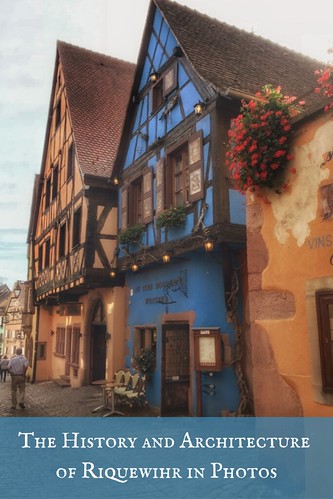
Alsace, located in far northeastern France, and bordered by both Germany and Switzerland, is an amalgamation of cultures. This strategic location was the reason for many wars, and the region has exchanged nationalities several times over the centuries. After World War II, it was once again (and forever) French.
Renowned for the fine wines produced here for over 500 years, Riquewihr is nestled between two Grand cru vineyards. The enormous wealth of the wine trade accounts for the spectacular homes built here by merchants and winemakers from the 14th to the 18th century.
A walk through the cobblestone streets of Riquewihr is akin to walking in an open-air museum. The Riquewihr tourist office, located in the center of the main street, provides a wonderful map of many of the significant buildings, along with a short history of each. A fun way to spend an hour or two is to get a map and locate each place, as I did one afternoon. For a sneak preview, follow along the photo story and be amazed at the number of medieval and Renaissance buildings in this storybook village set in the vineyards of Alsace.
Tip: When you visit, take your camera and try to go on a weekday to avoid the crowds.
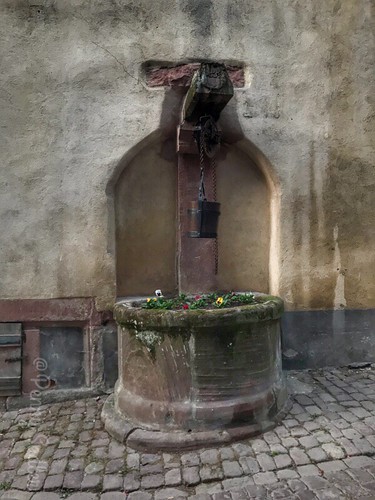
There are many fountains you can see in various places around the village. This was, of course, the main water supply...and some still work!

The Court of the winemakers. Notice that these houses are all stone, signifying the owners were wealthy merchants or winemakers. Riquewihr has the largest number of all stone houses in Alsace.

The blue building is now Au Vieux, a popular restaurant in Riquewihr. Notice all the window boxes filled with blooming flowers. This is a hallmark of the Plus Beaux Villages in France. Across the street, you can see a sign of the Christmas tree on the pink building. This is the Noelle store, open year 'round.

The house Schickhardt was built in 1606 by the architect of the same name. He was in the employ of the Duke Frederick the 1st of Wurttemberg (who was a property developer and military engineer). This house is now a beautiful shop, selling objects made of crystal. It was very hard to photograph, no matter the time of day. The streets of Riquewihr are narrow, and the buildings are remarkably tall.
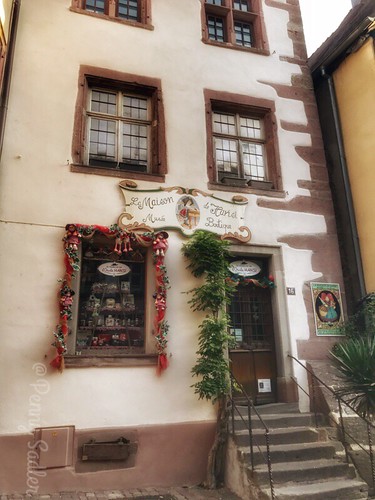
The entrance to the Hansi Museum. Hansi was one of the most famous Alsatian artists and charicaturists, and depicted Alsace with affection and humor. You can see over 150 of his works in the museum; there is a gift shop on the ground floor. There are many signs throughout Riquewihr and Colmar designed by Hansi. He is also known for his part in the resistance of the German occupation of Alsace during both World War I and World War II. The museum hours can be found on their website.

The House located at #13 rue du General de Gaulle. Notice that this is actually two buildings. On the left, you can see a gate (now a doorway) with the date 1565; on the right, the double oriel is quite elegant. Oriels allowed more light indoors, and provided a better view of the street scene below.
Also notice that this building is all stone. There is an inscription that commemorates the raising of the second level in 1709. It also says that year many vines and fruit trees were killed by severe frost throughout Europe. This is now a lovely cafe and great place to sit outside and people watch.
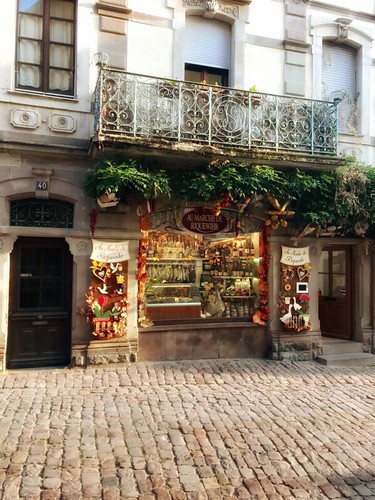
The Gourmet’s house, “A l’ etoile,” is now owned by the town of Riquewihr. It was rebuilt in 1686. The walls below the windowsills are decorated with the town’s coat of arms, a star, and a gourmet innkeeper bearing a jug and goblet. The sign was made by the artist Hansi.

The Protestant church as seen from the Schoenenberg vineyards of Riquewihr on a moonlit night. It was very romantic!

The Dolder tower, one of the most significant structures in Riquewihr, is still intact. Built in 1291, it is part of the original wall built around the village. It was a watchtower, and the design was meant to repel attacks. Today, you can go inside and enjoy the view over the village.
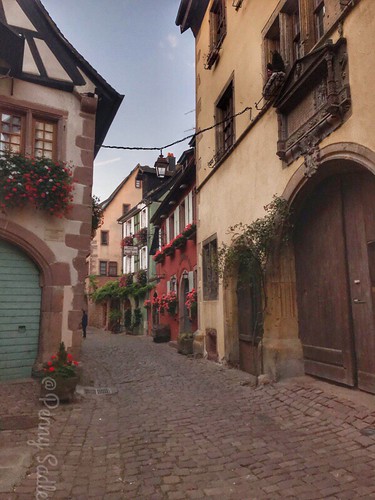
The house on the right with the two arches doorways is the Conrad Ortlieb house, built in 1574 for the gourmet Ortlieb. A gourmet was a sworn intermediary between the wine growers and the wine merchants. The two archways are coaching gates. One is cut at an angle to make it easier for horse-drawn vehicles to pass through. The bas-relief which decorates the facade says:
"Each may contemplate this building-it has been constructed to my design and I know that not all will find it pleasing."
On the right side, it says: "Oh Death, you have no hold over me In this house I live a life of luxury.” But Death replies, “Give up all this magnificence, you have built this house for another.” Amazing what one can do if one has a lot of money!

If you’d like to stay in one of the restored winemaker houses, check out the accommodations at I Love Riquewihr. The owners have fourteen apartments in the village, and are a wealth of information for visitors.

The tourist train will take you on a tour of the town and vineyards from April to October. All aboard!
Pin for later:
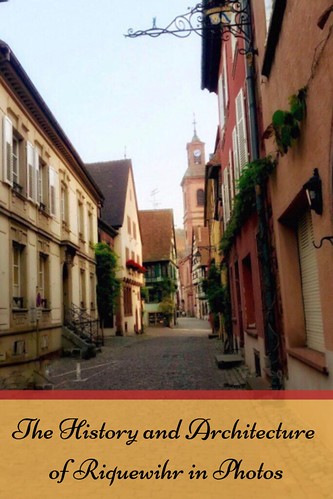
Read more about Riquewihr: Wine, Castles, and Culture: Top Reasons to Visit Riquewihr, Alsace
Penny Sadler, our lifestyle editor, is the founder of Adventures of a Carryon, a travel, wine, and culture site. Her background as a professional makeup artist in the film and television production world has honed her eye for detail, and served her well as a writer. She funds her passion for travel by hosting wine tastings and beautifying the world..and yes, by writing.
All photos courtesy and copyright Penny Sadler
